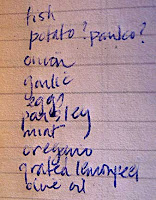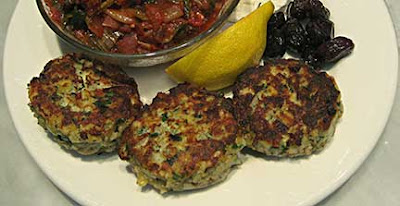Before I wrote Tastes Like Home: Mediterranean Cooking in Alaska, I rarely wrote down recipes, though I occasionally made a few notes about what I had prepared. If I ever went back to the notes, and I rarely did, they were incomprensible, full of half sentences and incomplete thoughts. I could sometimes read my handwriting, but too often the content was less than clear.
“Butter, golf.” read one such note. “4 dill.” read another. “Don’t table.” Don’t table? The mysterious scribblings meant nothing to me.
When I began work on Tastes Like Home, I knew I had to do better, to write more clearly, to be more precise. As I worked my way through the dishes that I ultimately included in the book, I typed up the details of that day’s effort as soon as dinner was over. I thought I was being disciplined. I thought I was writing recipes. I thought that what I had written would make it simple to put the book together.
I was wrong, very wrong. When I went to organize the book that became Tastes Like Home, I discovered my dutifully typed writings were merely more refined versions of the handwritten notes to myself, albeit slightly more intelligible. To go in a book, everything needed to be completely rewritten, and then rewritten again.
Doing a project the size of Tastes Like Home taught me many things, among them the need to write complete and finished recipes contemporaneous with cooking a dish. I promised myself that if I ever thought about doing another book, I would reform my ways, and discipline myself to write finished and complete recipes in small bites, day by day, as the food came out of my kitchen.
Tastes Like Home, The Blog is how I am keeping that promise.
So what goes into writing a recipe?
Inspiration comes first. Inspiration from glorious ingredients, inspiration from restaurants or other people’s cooking, inspiration from conversations about food, inspiration from reading or research, or inspiration that springs mysteriously into my mind at odd moments, or during nights of insomnia. Inspiration is the easy part. Once inspiration strikes, I plan the recipe in my mind. I carefully think through the components that make up the particular flavor I’m after. What ingredient is the focus of the dish? What are the high notes, or the subtle background flavors? As I think these things through, I often make a list of ingredients most likey to create the taste experience I’m after.
Once inspiration strikes, I plan the recipe in my mind. I carefully think through the components that make up the particular flavor I’m after. What ingredient is the focus of the dish? What are the high notes, or the subtle background flavors? As I think these things through, I often make a list of ingredients most likey to create the taste experience I’m after.
At this point, I enter the kitchen and start cooking, but a kind of cooking that is unlike my normal style. Normally, I don’t measure my ingredients. Normally, if I taste what I’m making and add something to give the dish a flavor boost, I won’t remember a day later what exactly I added. I’ll remember being happy with how my dish tasted, but exactly recreating it is impossible.
In contrast to my normal free-form style, when I intend to share a recipe with others, I measure everything, a task that requires a high degree of discipline (not my strong suit). I frequently stop myself mid-air as I’m about to add an ingredient, having realized it has not yet been weighed or measured. I add flavorings in smaller increments than normal, so I can find the exact point at which a recipe has enough, but not too much, of a particular flavoring. And most importantly, I write down everything while I’m cooking. At least I try to do this, I really try. Sometimes I succeed. But not always, so my back-up strategy is to write the recipe in finished form within hours after I have finished cooking. At this stage, I remember exactly how I prepared the dish, and what went into it, and in what order.
And most importantly, I write down everything while I’m cooking. At least I try to do this, I really try. Sometimes I succeed. But not always, so my back-up strategy is to write the recipe in finished form within hours after I have finished cooking. At this stage, I remember exactly how I prepared the dish, and what went into it, and in what order.
If I don’t take notes while I’m cooking and don’t finalize a recipe the same day I cooked it, I make the dish again before I put its recipe in writing. I want to make sure I didn’t leave anything out, so that anyone who uses the recipe will enjoy its flavors, just as I did when I originally decided it was worth passing on to others.
A couple days ago, I finalized a recipe for Savory Fish Cakes, called Psarokeftedes in Greek. I once enjoyed this dish in a seaside taverna in Greece, and wanted to make it using ingredients available in Alaska. The day before I made the fish cakes, we had fresh halibut for dinner; the leftovers were perfect for fish cakes. (Note: The Alaska halibut season closes tomorrow -- 11/15 -- at noon, so there is no time like the present to buy halibut.)
The Savory Fish Cake recipe turned out well. My husband pronounced them the best he’d ever had (and he is not shy about telling me when a dish could be better or that he never wants to eat it again). My friend Teeny had been over to take pictures of me cooking and I gave her some raw fish cakes to cook at home; both her and her husband pronounced them excellent. I loved them and ate too many.
Having succeeded in achieving the taste I wanted, I only had to write down the recipe, which I did immediately. My work is done. The recipe is complete and final and ready to be made again, in your kitchen and mine. Savory Fish Cakes (Ψαροκεφτέδες)
Savory Fish Cakes (Ψαροκεφτέδες)
Serves 4 – 6 (makes 12 fish cakes)
Savory Fish Cakes are an ideal way to use up leftover fish. However, if you don’t have any leftovers, you can quickly poach the fish needed for the cakes: cook 3/4 pounds of raw fish until done in simmering water, a little wine, a few peppercorns, 3 bay leaves, and salt. The shaped fish cakes can be made hours ahead of time, and refrigerated until ready to use. Although it is not absolutely necessary to chill the fish cakes before cooking them, doing so helps them hold together as they brown.
2 cups cooked, peeled, and grated potatoes
1 1/2 cups diced onion, 1/4” dice
2 tsp. finely minced garlic
2 eggs
1 Tbsp. finely grated lemon peel
1/3 cup minced fresh parsley
1 tsp. dried oregano, crushed
2 Tbsp. minced fresh mint
2 Tbsp. olive oil
Salt
Freshly ground black pepper
1/4 cup olive oil for frying Thoroughly mix all the ingredients together in a bowl; this is easiest to do with your hands. Divide the mixture into 12 portions; a 1/4 cup scoop or measuring cup works well for this task. Shape into flat cakes, and place them on a waxed paper lined baking sheet, cover with plastic wrap, and refrigerate until you are ready to cook.
Thoroughly mix all the ingredients together in a bowl; this is easiest to do with your hands. Divide the mixture into 12 portions; a 1/4 cup scoop or measuring cup works well for this task. Shape into flat cakes, and place them on a waxed paper lined baking sheet, cover with plastic wrap, and refrigerate until you are ready to cook.  Heat the olive oil in a large frying pan. Fry the fish cakes, in batches if necessary (don’t crowd the fish cakes or they won’t brown properly). The fish cakes are done when they are golden-brown on both sides and cooked through. Drain on paper towels and serve.
Heat the olive oil in a large frying pan. Fry the fish cakes, in batches if necessary (don’t crowd the fish cakes or they won’t brown properly). The fish cakes are done when they are golden-brown on both sides and cooked through. Drain on paper towels and serve.
Wednesday, November 14, 2007
Anatomy of a Recipe (with Recipe for Savory Fish Cakes / Ψαροκεφτέδες)
2 cups flaked, cooked halibut, rockfish, cod, or other white fish (5/8 pound)
~~~~~~~
This is my entry for Leftover Tuesdays, sponsored this month by Pam at Project Foodie.
Subscribe to:
Post Comments (Atom)




4 comments:
Good thinkin on your feet with using halibut. The only thing missing is a Skordalia for that fish, dip-dip-dip!
Ha Peter, you are so right! You'll be happy to know I served it with the Roasted Beets and Celery Root Skordalia in the posting before this one. Dip-dip-dip, indeed!
i am also like you where i would replay the kitchen scene where i had just cooked and try my best to note down the recipes, especially hard for chinese cooking
Rokh, thanks for visiting. All cooks, no matter where they live, share so many common experiences.
Post a Comment